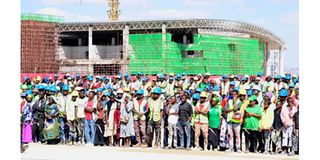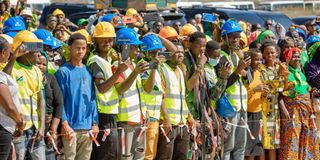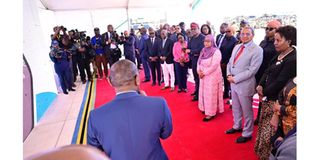How AfDB-backed projects anchor Dodoma’s urban, economic rise

What you need to know:
- The two leaders inspected ongoing works at the 112.3-kilometre Dodoma Outer Ring Road, before touring the Msalato Airport, which was subsequently named Akinwumi Adesina Road in honour of the AfDB chief.
Dar es Salaam. President Samia Suluhu Hassan has underscored the significance of major infrastructure projects financed by the African Development Bank (AfDB), citing their role in bolstering Tanzania’s economic transformation, regional connectivity, and the country’s administrative capital.

Speaking on Saturday, June 14, 2024, after inspecting several AfDB-funded projects—including the Sh330 billion Msalato International Airport—President Hassan highlighted their strategic importance in supporting Dodoma’s rapid urban and economic growth.
The Head of State was accompanied by AfDB President Dr Akinwumi Adesina, who is nearing the end of his tenure.
The two leaders inspected ongoing works at the 112.3-kilometre Dodoma Outer Ring Road, before touring the Msalato Airport, which was subsequently named Akinwumi Adesina Road in honour of the AfDB chief.

“These projects address the realities of Dodoma’s fast-rising population and the increasing demand for efficient transport infrastructure,” President Hassan said.
“To ease congestion, we initiated the outer ring road, and to meet rising air traffic needs, we launched the Msalato International Airport project after the current Dodoma Airport could no longer cope, even after substantial upgrades,” she added.

She noted that Dodoma is strategically located along two key transnational corridors: the Central Corridor linking Dar es Salaam with Rwanda, Burundi, and the Democratic Republic of Congo (DRC), and the Trans-African Highway connecting Cape Town to Cairo.
During the nationally televised event, President Hassan listed several road projects implemented through AfDB funding, including: Kabingo–Kasulu–Manyovu (260km); Bus Rapid Transit Phase II (20.3km); Mnivata–Newala–Masasi (160km); and Namtumbo–Tunduru (193km).
Others are: Dodoma–Iringa (260km); Dodoma–Babati (188km); Sakina–Tengeru (14km); Arusha Bypass (42.4km); Mbinga–Mbambabay (66km); Tunduru–Nakapanya–Mangaka–Mtambaswala (202.5km); and Tabora–Koga–Mpanda (342km).
She said AfDB has also played a crucial role in supporting the Tanzania Agricultural Development Bank (TADB) to finance farmers, as well as in sections of the Standard Gauge Railway (SGR), including Tabora–Kigoma and Uvinza–Musongati.

“AfDB has been a reliable partner in Tanzania’s infrastructure and economic development,” she said, urging the Ministries of Works and Transport to ensure the timely and high-quality execution of all road, rail, and airport projects by contractual obligations.
The President also encouraged Dodoma residents to cultivate sunflowers and grapes along the ring road corridor to beautify the area and enhance its economic potential, while stressing the need to safeguard public infrastructure developed at considerable cost.
For his part, Dr Adesina revealed that Tanzania has received $9 billion in AfDB funding since the Bank’s inception, with $4.73 billion—equivalent to 53 percent—disbursed during his tenure from 2015 to 2025.

He attributed the robust funding levels to the Bank’s confidence in Tanzania’s leadership, supported by consistent growth in agriculture, tourism, mining, financial services, manufacturing, construction, and other key sectors.
“Sound macroeconomic and fiscal policies have boosted Tanzania’s real GDP growth from 5.1 percent in 2023 to 5.6 percent in 2024. We project this will rise to 5.9 percent in 2025 and reach 6 percent the year after, positioning Tanzania among Africa’s fastest-growing economies,” he said.
Dr Adesina said AfDB support to Tanzania has grown from $2.2 billion in December 2021 to $3.74 billion by the end of 2024.
As of May 2025, the Bank’s active transport infrastructure portfolio in Tanzania stood at $2.41 billion.
“These investments span national roads, international airports, and regional rail systems. They reflect our shift from traditional road investments to integrated transport solutions, helping position Tanzania as a key logistics and trade hub in the region,” he said.
Former President Jakaya Kikwete, who attended the event, said Msalato International Airport had long been a dream of national leaders—from the country’s founding fathers to the fifth-phase administration.
“We commend you, Madam President, for delivering an international airport capable of handling even Airbus A380 aircraft. The outer ring road is also a timely response to the growing traffic challenges in Dodoma. May God enable us to witness the Mtumba Interchange upon its completion,” said Mr Kikwete.
Works Minister Abdallah Ulega said key roads in Dodoma were earmarked for major rehabilitation.
These include the Chamwino–Kimbinyiko road (32km), which will be upgraded to four lanes, including two Bus Rapid Transit (BRT) lanes.
“The Iringa Road from Image to Mkanze (7.5km), and the Dodoma–Arusha Road from Wajenzi Junction to the Msalato Airport Junction (8.5km), will also be significantly expanded,” Mr Ulega said.
Transport Minister Prof Makame Mbarawa said the 4,500-acre Msalato International Airport will attain ICAO EF Grade status upon completion.
“Just yesterday, a Bombardier Q400 successfully landed there during a trial exercise,” he said, commending the government for enabling ministers to confidently deliver major infrastructure projects.
Dodoma outer ring road project
Mr Ulega said the 112.3km Dodoma Outer Ring Road project will alleviate congestion in the city and improve regional connectivity along the Cape Town–Cairo corridor.
The first phase, covering the 52.3km Nala–Mtumba–Msalato stretch, is being constructed by China Civil Engineering Construction Corporation (CCECC), supervised by Inter-Consult Ltd. It is currently 89.8 percent complete.
The second phase—60km from Ihumwa Port to Matumbulu and Nala—is being executed by Avic International Engineering Company in partnership with Arab Constructing Company. Crown Tech Consult (CTC) Ltd is providing consultancy services. This phase is 85.01 percent complete.
The road project has created 922 jobs—867 for Tanzanians and 55 for foreign workers.
Over 2,000 people have indirectly benefited from the initiative. Complementary services such as schools, health centres, and tree-planting initiatives are also underway.
Progress on Msalato Airport
Tanroads Director Mohamed Besta said the Msalato International Airport project comprises two main components.
The first package, valued at Sh165 billion and executed by Sinohydro Company Ltd, covers movement areas including the runway, taxiways, and aircraft aprons. This phase is 89.9 percent complete.
The second package involves the construction of support infrastructure, including a terminal building, air traffic control tower, fire and rescue station, meteorological and radar facilities, and a power plant. Progress on this package stands at 55.93 percent.
Once operational, the airport will accommodate Airbus A380s and comply with ICAO Code 4E standards, making it one of the region’s largest airports.
A documentary screened during the visit showed that the airport will feature a 3,600-metre runway, aprons for aircraft parking, an Airfield Ground Lighting (AGL) system, Category III Instrument Landing System (ILS), internal roads, a 500-vehicle car park, a 41.3km security fence, and essential utility infrastructure.
Mr Besta said 633 workers—including 34 women—are currently employed on the movement areas phase, supported by 156 machines, equivalent to 125 percent of the contractual requirement.
The second phase employs over 522 people, 93.5 percent of whom are Tanzanians. The terminal building will have the capacity to handle 1.5 million passengers annually, and the control tower will rise to 56.2 metres. The project is being implemented by Tanroads with AfDB funding.



